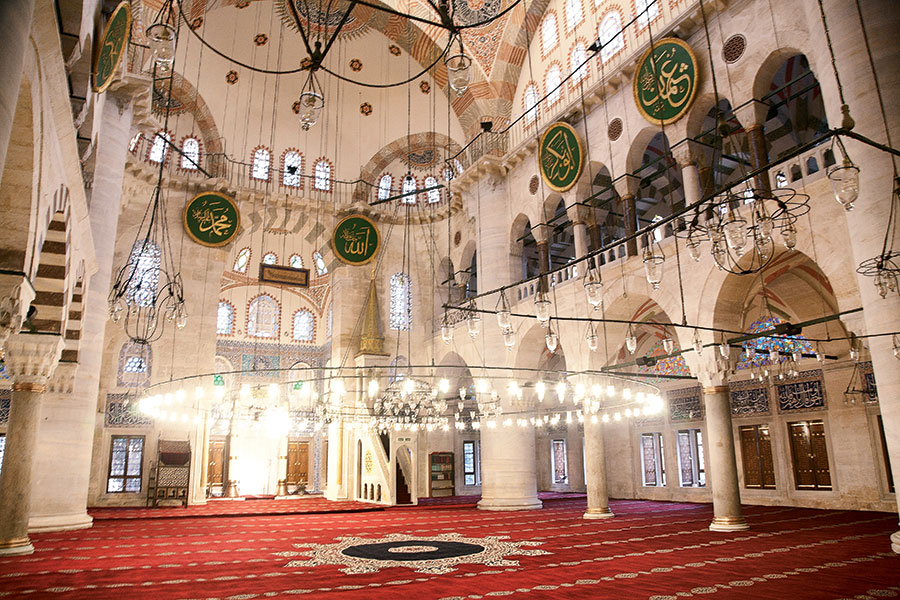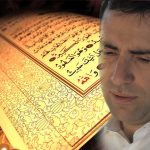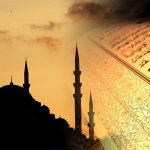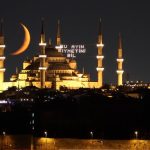Who is the late Kapudan-ı Derya (navy commander) Kılıç Ali Pasha, the founder of this temple?
His mother was a Turkmen Yoruk from Southern Anatolia and his father was a sailor from Aydın. He was one of the greatest admirals of the 16th century, who spent his life at sea among the Turkish Nation, the only nation in the world that accepted Islam not by force of arms but by its own desire and will, who was determined to plant our glorious flag, the only symbol of Islam and Turkishness, on the bastions of the castles in the Mediterranean in order to turn the vast Mediterranean into a Turkish lake, and who devoted his existence to this sacred purpose. He played an important role in the victories of the Turkish navy in the Mediterranean and in the history of the Ottoman Empire, which is full of honour, thanks to his courageous, skilful, dexterous structure and agile intelligence. Especially during the Battle of Inebahtı, thanks to his great skills in manoeuvrability, the fleet under his command turned the enemy fleet, sank many ships and defeated them by causing great casualties, which led Sultan Selim II to give him the name “Kılıç” and the office of “Kapudan-i Derya”.
With a life span of 625 years, Kılıç Ali Pasha Mosque and Complex, which was built as a “mansion mosque” by sitting on the ground obtained by filling the sea in the 16th century, located in Tophane, one of the distinguished districts of Istanbul, which was the capital of the Ottoman Empire, the world’s largest world empire with its unique beauty, and one of the most rare works of world cultural heritage with its 430 years of history;
The result of Kılıç Ali Pasha Mosque’s unadulterated faith and belief, his life in Islam, and the result of the grace of Allah in the autumn of such an exceptional life; is that he was instrumental in the construction of this work with superior features that have never been encountered before.
Due to his advancing age, he decided to build a Mosque Sharif and a complex that will be remembered with charity and mercy for eternity in order to ensure that the adhan-i Muhammad will be recited five times a day as a work that will perpetuate his own name, and that the Ummah of Muhammad will worship in it and pray to Almighty Allah (c.c.) for the survival of our nation and state and the victory of our armies. Between the Ottoman Sultan of the period, Murad III Khan;
“He is the serdar of the seas, let him build his mosque on the sea if he can! Otherwise, I will not give him an inch of land!”
“Our sultan is right, our home and our place are the seas; then it would be appropriate to build our mosque on the seas!”
As a result of these dialogues, let us inform you about this unique temple rising above the sea, which they started to build with very fine and precise calculations with the great master Mimar Sinan.
It is a very beautiful example of Turkish architecture, which reached its peak with Mimar Sinan, and the last magnificent work of Mimar Sinan, each of which is a masterpiece of art.
The great master Mimar Sinan said the following about Kılıç Ali Pasha Mosque, which he said would resemble Hagia Sophia, which he had been studying for years, and which he planned to bring into being by adding elements of Turkish architecture:
“Even if the seas rage and the raging waves break over the top of the dome, this temple will remain until doomsday, in the name of Allah!”
Although the colour of its stone has been blackened by the black smoke from the chimneys of ferries and buildings for years, Kılıç Ali Paşa Mosque is a small example of the pink-coloured Hagia Sophia.
Kılıç Ali Pasha Mosque and Complex is surrounded by a large courtyard. The entrance to the courtyard is through four separate doors on the symmetrical walls. There is a fountain with 16 marble columns at the base of the wall and in the centre of the courtyard, surrounded by eight marble columns and covered with an elegant dome.
From the courtyard with the fountain, one passes to the inner courtyard with iron railings. There are two last congregation spaces here, one with five domes and six columns, and the other covered with a canopy decorated with the most elegant examples of wood, wood carving and carving.
In general, the mosque has more ornamental elements compared to Sinan’s other works, and the most common material in both the last congregation area and the interior decoration of the mosque is colourful tiles decorated with floral motifs reflecting the characteristics of the 16th century, but the mosque is also extremely rich in calligraphy.
The mosque is entered through the main portal directly opposite the mihrab and through two doors on either side of the courtyard. The magnificent wooden door wings, which complement the magnificent decoration of the entrance, are inlaid with delicate inlays of ivory, ebony and apple wood, embossed embroideries and metal rosettes on kündekari.
One of the first sights that catches the eye in the interior of the mosque is the exquisite tiles in white on navy blue, encircling the upper parts of all the walls, and the most marvellous examples of manuscripts written on them.
The mosque, which has a complete rectangular architecture, has a large central area and side galleries with side galleries and mahfels, and a large main dome with a pendant dome resting on four marble elephant legs, and is supported by two small half domes, one on the side of the mihrab and the other on the side of the entrance door. There is also a small dome at each of the four corners. The usable interior floor area of the mosque is 760 square metres, and together with the upper mahfels, which give the impression of a second floor, it has a congregation capacity of five thousand people. Together with the 24 windows of the large dome, the mosque has a total of 147 windows. The colourful motifs and patterns embroidered on the glass in the wide curved windows are reflected on the ground in the parts where the sun hits and this colour harmony presents a different view. Just above the rectangular shaped calligraphy panels above the ground windows, the second row of large arch-shaped windows are decorated with colourful stained glass with floral patterns.
The most obvious feature of the Ottoman architectural taste is the mihrab in the Bursa style, which is protruding, covered with a half dome, the pedestal section and the inner face are marble, and the entire surface is covered with exquisite Iznik tiles with flowers. Since all the arched windows on the part of the qibla wall facing the main space, which are decorated with tiles, are also decorated with elegant stained glass windows, the harmonious distribution of the light filtering through the windows has made this place the focus of the mosque with the simple splendour created by all this decoration in great harmony.
On the right side of the mihrab is a very high pulpit made entirely of inlaid marble. With its pointed and elegant cone on its top, it adds a separate splendour to the harmony in the interior view of the mosque.
From the muezzin mahfel on the right side of the entrance door, the muezzins follow the imam and the congregation and give the kamet reminding them to start the prayer, and when they salute, they perform the muezzin reminding them of their exit from the prayer, and according to the performance of the prayer, they make the rosaries with the entrance intermediate and final readings.
The high minaret on the right side of the mosque in relation to the mihrab has a single balcony, polygonal body and is very elegant.
This great sanctuary dazzles the eyes with its exterior appearance, and makes the hearts rejoice with the harmony and splendour of its interior appearance. As in all the temples of Islam, the beauty, elegance and brightness in Kılıç Ali Pasha Mosque is not found in Hagia Sophia. Because this heart-opening is due to the spirit and light that the Islamic architects have taken from the light of faith.
The very special model of Kılıç Ali Pasha Mosque and Complex, which is a first and has no example in any mosque, including the selatin mosques in our country, has also taken its place in the mosque courtyard. Our mosque is appreciated by local and foreign visitors with great admiration and admiration.
The madrasah is located to the southeast of the mosque and has a courtyard adjacent to the enclosure walls, which is not completely square in the centre. The large rooms behind the porticoes and on the mosque side are reserved for use as classrooms. There are also many large and small rooms reserved for kitchen, bathroom and various services.
It is one of the three largest domed baths of Istanbul, which is a masterpiece bearing Mimar Sinan’s signature in every aspect in terms of architectural style and known today with the phrase ‘Historical Kılıç Ali Paşa Bath’ on its door. It is one of the rare baths with its wide porticoes, fountains, halvet and various cells and showers with recesses and protrusions, large navel stones, countless kurnas with their echoes echoing the bright dome, and the layout plans of the coldness, warmth and warmth sections, which differ from other historical baths and with two warmth sections. Restoration works are still in progress and it is expected to be put into service in 2012.
In the northwest corner of the courtyard, there is a Sebil, which has three porticoes facing the street and whose construction was intended by its founder to “distribute all kinds of soft drinks free of charge for the sake of Allah in order for thirsty people to extinguish their fever, especially on Mubarak days”. During the restoration, the wooden joinery of the Sebil was also reconstructed.
Kılıç Ali Pasha, the sergeant of the seas, who spent his life on the seas, had his grave and tomb built on the sea again in the garden on the mihrab, the qibla side, which is the front of the mosque, in order to declare his love for the sea to the whole world. The massive walls of the entrance niche of the tomb, whose outer walls are octagonal in shape, built of cut stone and covered with a double dome, supported the arches carrying the dome. As it can be understood from this point, the architecture of Kılıç Ali Pasha’s mausoleum reveals a different application, the like of which is rarely encountered. Even though he had mixed the enormous pride and splendour of an era with his humility, he was buried in his eternal resting place here when he travelled to the eternal realm in order to hear the splash of the waves that flutter for eternity.
Now he continues his eternal sleep under his modest dome and in his green covered cist. May Allah have mercy on him.
Within the scope of the Istanbul 2010 European Capital of Culture project, the restoration work initiated by the Istanbul 2010 European Capital of Culture Agency and the Prime Ministry Istanbul Foundations 1st Regional Directorate of Foundations for the restoration and structuring of Kılıç Ali Paşa Mosque and Complex in accordance with the history of our cultural values has been successfully completed, our mosque has been made ready for worship, and this issue has been the occasion for the satisfaction, congratulations and appreciation of the mosque community.
Life in Kılıç Ali Paşa Mosque
When you step through the outer gate of Kılıç Ali Paşa Mosque, your guide will find you immediately; Peace…
Even the stones seem to chant with you as you move with heavy steps from the outer courtyard and enter the inner courtyard; saying Allah…
If the mercy of our Allah is raining, you have come to such a place that everything is preparing you for the spiritual atmosphere and worship inside with a divine secret. Especially if the Holy Qur’an is recited by a hafiz with a beautiful voice inside, the spiritual pleasure peaks in the ears and conscience of the human being.
The most famous hafiz, mawlithans, muezzins and imam khatibs of Istanbul are carefully invited and assigned to this magnificent temple, and the hafiz perform their hıfz and qiraat, the mawlithans perform the mawlidi-i sharif, the muezzins perform the adhan-i Muhammadi, and the imams perform the imamate in the most beautiful way. Especially the Ramadan muqabalahs performed by hafiz and the prayers performed by muezzins with awe after the call to prayer and worship of Allah find a completely different meaning in the cool environment of this mansion mosque.
On the other hand, the hymns and odes rising from Kılıç Ali Pasha Mosque every Sunday morning at dawn attract the believers who know this to the sanctuary in such a way that being in this spiritual atmosphere is very meaningful. It creates such a picture in the minds. It is as if “in the testimony of the angels, it is the presence of the heavenly ones in the world”. They perform the morning prayer in peace with beautiful Qur’an recitations, have a nice breakfast in the courtyard of the mosque and experience the privilege of saying hello to the day with besmela and prayer. With each new congregation added to this circle, an appointment is made by saying “… stay with health and good health, love and affection to meet next week”.
Our mosque in the Tophane neighbourhood of Beyoğlu district, connected to Fatih district, which is called Old Istanbul, by the Galata Bridge, with its exceptional architecture in this historical texture, with its attractive stance, the Muslim people of the Republic of Turkey, especially the young population, men and women, especially on Fridays, with the congregation formed by the residents of the Tophane area, especially on Fridays, apart from the time prayers, are instrumental in performing Friday prayers with us.
We closely observe that the Muslim and Arab tourists visiting our country this year, especially in Istanbul, show as much interest in historical places as they do in shopping centres.
The large and small hookah cafes in and around the Tophane quay and the restaurants and boutique hotels offering distinguished flavours of rich Ottoman and Turkish cuisine offer unlimited opportunities in touristic services with their competent staff. This is an important factor for people to prefer these places rich in nature and historical texture as a meeting address for resting, staying and chatting.
The Kılıç Ali Pasha Mosque, where we will hear the call to prayer that will rise from its minarets forever, where we will perform our prayers in awe, where we will express our prayers and supplications to Almighty Allah with our hearts and tongues, and where the cries that will echo in the sky with muqabals, mevlits and recitations of the Holy Qur’an will continue from generation to generation, will maintain its importance as the mosque where the state officials, especially the cadets and the elite community always pray and receive support.
Just as in the 16th century, all the ships docking at the shore were extremely impressed by the splendour of this giant construction, the call to prayer rising from this minaret and the fact that it was built by a Captain-ı Derya, today, tourists who come to visit Istanbul with touristic cruise ships carrying thousands of passengers docking at the Tophane Dock cannot take their eyes off the mosque with amazement and curiosity.
We are enlightened by the light of our holy religion Islam, our holy book the Holy Qur’an, and we pray that all other believers in our world, which our Almighty Lord has blessed us with infinite and unique blessings for us His servants, can one day taste the flavour of the monotheistic belief of Islam by taking inspiration from our brotherhood of religion and belief.
This work, which is a spiritual investment with its 430 years of history until today and even until the Day of Judgement, will be on the way to heaven with the prayers and wishes of its congregation, Allah willing.
From the pen of Selman Okumuş
Turkish Airlines Skylife Magazine March 2012









